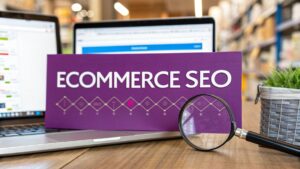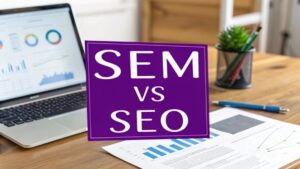A solid ecommerce SEO strategy is the digital equivalent of getting a storefront on the busiest high street in town. It puts your brand right in front of customers who are actively looking for the very things you sell. A well-built strategy doesn't just attract searchers; it turns them into shoppers by focusing on the core pillars of technical health, on-page optimisation, and building authority.
The Blueprint for Ecommerce SEO Success
Stepping into online retail can feel like a lot to handle, but a clear SEO plan is your blueprint for growth. This isn't about finding quick hacks or trying to game the system. It’s about methodically making your online shop easier for both search engines and people to find and love. Think of it as a long-term investment that builds a steady stream of organic traffic and sales, freeing you from relying only on expensive ads.
Before you get into the nitty-gritty, it helps to have a solid business foundation in place. For example, if you're just starting out, a guide on how to start a phone case business can ensure you launch on the right foot. A strong start makes any SEO work you do later much more effective.
To really get to grips with what makes a successful ecommerce SEO strategy tick, it's best to break it down into its fundamental components. The table below outlines these core pillars, their goals, and the impact they have on your business.
Core Pillars of Ecommerce SEO
| SEO Pillar | Primary Goal | Key Activities | Business Impact |
|---|---|---|---|
| Technical SEO | Ensure search engines can easily crawl, index, and understand your site. | Site speed optimisation, mobile-friendliness, secure connection (HTTPS), clean URL structure. | Improved rankings, better user experience, and higher crawl efficiency. |
| On-Page Optimisation | Make individual product and category pages relevant for target keywords. | Keyword research, optimising titles and descriptions, high-quality images, internal linking. | Higher click-through rates, increased traffic to key pages, and better conversion potential. |
| Content Marketing | Attract and engage customers at every stage of their buying journey. | Writing blog posts, creating buying guides, producing video content. | Builds brand authority, attracts organic traffic, and nurtures potential customers. |
| Authority Building | Earn trust and credibility from search engines and users. | Acquiring high-quality backlinks from reputable websites, managing online reviews. | Boosts domain authority, improves search rankings, and drives referral traffic. |
Each pillar supports the others, creating a robust framework for sustainable growth. A balanced approach ensures no single weakness undermines your overall efforts.
At its heart, a winning strategy is built on four interconnected pillars. If you neglect one, the whole structure can become wobbly, making it much harder to rank well and turn visitors into customers.
-
Technical SEO: This is the foundation of your entire website. It’s all about making sure your site is fast, secure, mobile-friendly, and simple for search engines like Google to crawl and index.
-
On-Page Optimisation: This pillar is all about fine-tuning individual pages, especially your product and category pages. It covers everything from keyword research to writing compelling descriptions and using great images.
-
Content Marketing: Here, the focus is on creating genuinely useful content—think buying guides or helpful blog posts—that attracts customers at different points in their journey and positions your brand as an expert.
-
Authority Building: This is about earning trust and credibility. It’s done by getting high-quality backlinks from other respected websites, which signals to search engines that your shop is a reliable source.
This diagram helps visualise how these four pillars—Technical, On-Page, Content, and Authority—all work together to drive ecommerce success.
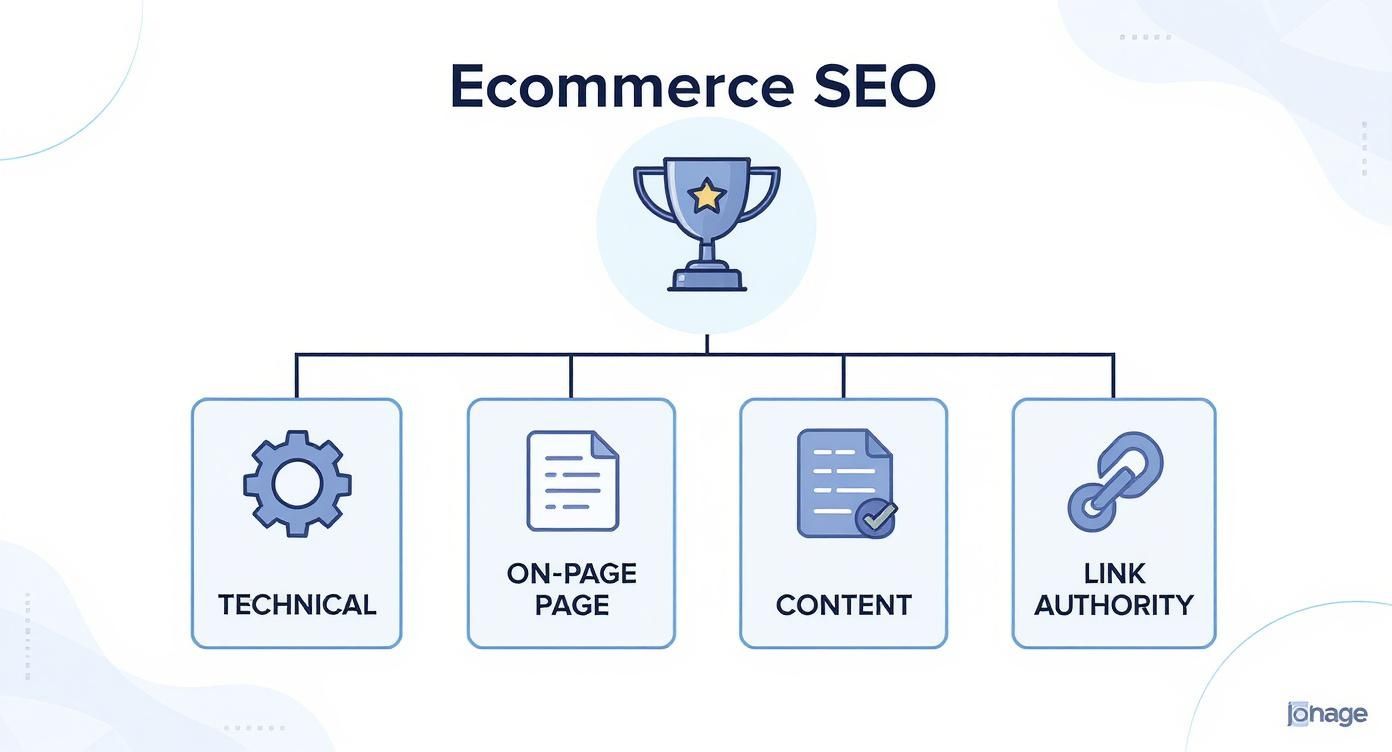
As you can see, it's all about balance. Each pillar props up the others to create a powerful, revenue-generating machine.
The Tangible Value of Organic Search
So, is all this effort really worth it? Absolutely. Research shows the average UK eCommerce brand ranks organically for around 1,783 keywords. That translates to roughly 9,625 organic visits every single month.
If you had to pay for that same traffic through search ads, it would cost an estimated £11,790.58 per month. This makes it crystal clear that a well-executed SEO strategy is one of the most cost-effective ways to drive consistent, high-quality traffic and achieve long-term growth for your online business.
Building Your Technical SEO Foundation
Before you can even think about selling a single product, your online shop needs a rock-solid technical foundation. This isn’t a nice-to-have; it's the absolute bedrock of any e-commerce SEO strategy that actually works.
Think of it like this: your website is a massive warehouse, and Google is your star stock picker. If the aisles are cluttered, the signs are wrong, and the lights keep flickering, that stock picker is going to get frustrated and leave. They won’t be able to find a thing.
Technical SEO is all about making sure your ‘warehouse’ is easy for search engines to crawl, understand, and index. It's about creating a smooth experience not just for bots, but for your actual customers too. A technically sound site is fast, secure, and simple to get around, all of which directly impacts how you rank.
Crafting an Intuitive Site Architecture
Your site’s architecture is its blueprint. Get it right, and you create clear pathways that help spread authority (often called "link equity") from your homepage down to your most important category and product pages. For an online store, a simple, logical structure is everything.
A good rule of thumb is to keep your key pages no more than three clicks away from your homepage. This "three-click rule" is a lifesaver for both users and search engine crawlers, ensuring nothing important gets lost in a maze of links.
- Homepage: The front door. This is where most of your authority starts.
- Category Pages: Broad buckets for your products (e.g., 'Men's Trainers', 'Women's Jackets').
- Sub-Category Pages: Getting more specific (e.g., 'Men's Running Trainers', 'Women's Winter Jackets').
- Product Pages: The individual item pages. This is where the magic happens.
This kind of clear hierarchy makes browsing feel natural and helps search engines grasp the relationship between your pages, a crucial piece of the puzzle.
A well-organised site doesn’t just improve SEO; it enhances the user experience. When customers can find products quickly and easily, they are far more likely to make a purchase, reducing bounce rates and signalling positive engagement to Google.
Optimising for Speed and Mobile Users
In today’s market, speed isn’t a luxury—it’s an expectation. Site speed is a confirmed ranking factor, and Google is watching closely. They use a set of metrics called Core Web Vitals which essentially measure the real-world experience of your users, focusing on how fast things load, how quickly the page becomes interactive, and whether it’s visually stable.
Just as critical is mobile performance. Most online searches now happen on a phone, so Google has switched to mobile-first indexing. This means it primarily looks at the mobile version of your site to decide how to rank you. If your shop is a clunky mess on a smartphone, your rankings will take a hit everywhere.
Sadly, technical problems are still rampant. One study found that 62.4% of eCommerce sites had at least one broken internal link, a surefire way to annoy customers and block search engine crawlers. Even worse, a staggering 70.5% of eCommerce sites were rated as 'needs improvement' on key performance metrics.
Implementing Clean URLs and Internal Links
The final pieces of your technical foundation are clean URLs and a smart internal linking strategy. Your URLs should be simple, readable, and packed with relevant keywords.
- Bad Example:
yourshop.co.uk/prod_id=123?cat=45B - Good Example:
yourshop.co.uk/womens-jackets/waterproof-puffer-coat
The good example tells both a person and a search engine exactly what they’re going to find. It’s clear, concise, and helps you rank for those specific terms.
Internal links are the threads that connect the pages of your site. Use them wisely. When you write a blog post, link to relevant products using descriptive text (the clickable bit, known as anchor text). From a category page, link down to specific items. This helps spread authority around your site and keeps people clicking and exploring for longer.
Giving your site a thorough technical health check is the essential first step. If you're wondering where to start, our technical SEO audit checklist is a brilliant resource for spotting and fixing the most common issues.
Mastering Product and Category Page Optimisation
Think of your product and category pages as your digital shop floor. This is where the magic happens. They're the most critical conversion points in any e-commerce SEO strategy, turning casual browsers into paying customers. Getting these pages right isn't just about listing features; it's about crafting an experience that answers questions, builds trust, and makes the path to checkout feel effortless.
Your category page is like a well-organised department, guiding shoppers. Your product page? That's the expert salesperson, ready to close the deal. Both need to be perfectly tuned to capture commercial intent—the mindset of someone who's ready to buy. This all comes down to a sharp focus on keyword research, persuasive writing, and a bit of technical precision.
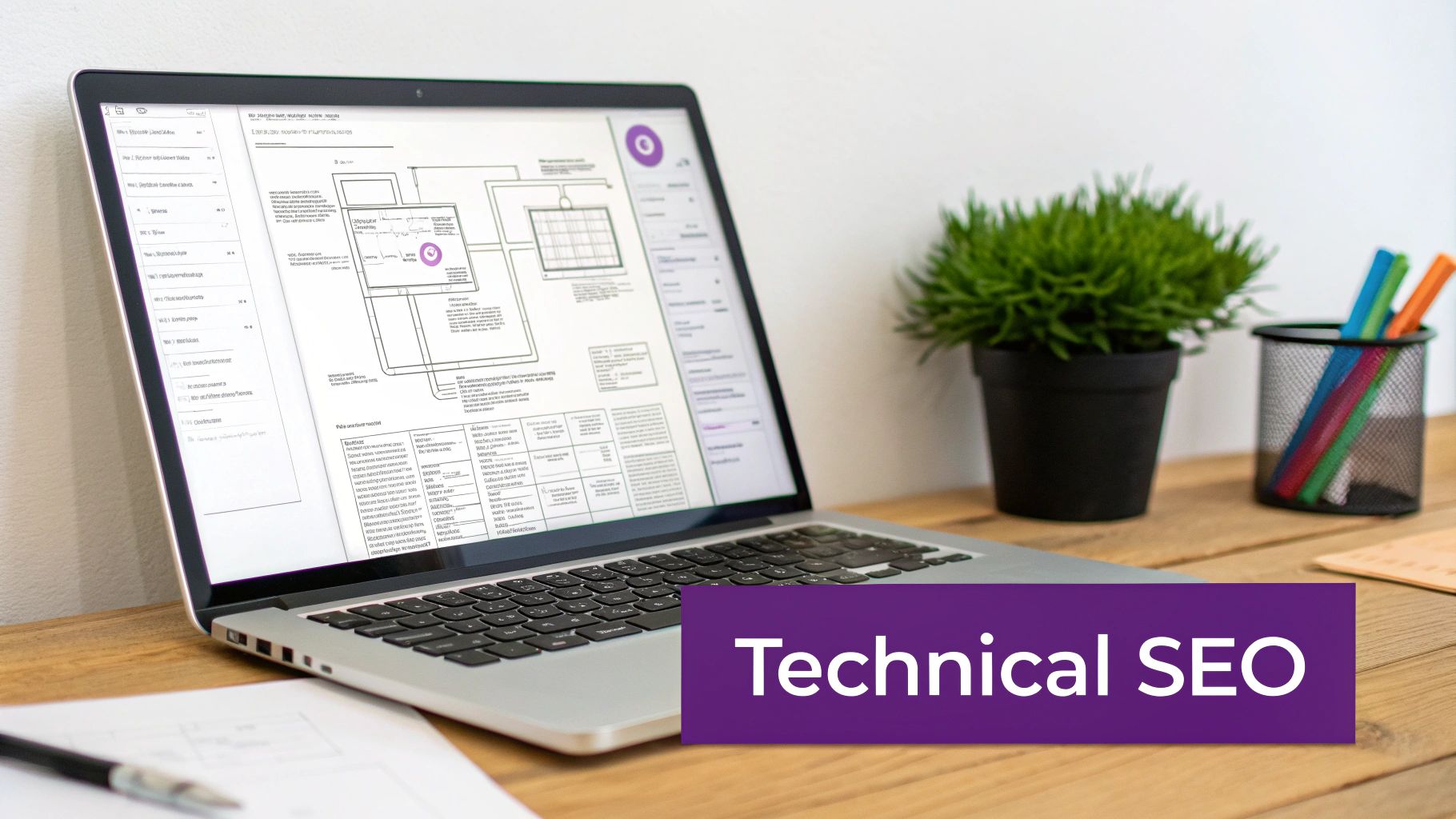
Crafting Compelling Product Descriptions
So many online stores fall into the trap of using generic, manufacturer-supplied descriptions. This is a huge mistake. Not only does it create duplicate content problems for Google, but it completely fails to connect with your audience. A great product description doesn't just describe; it sells the solution to a customer's problem.
Forget just listing specifications. Weave them into a story that highlights the benefits. How does that feature make your customer's life easier, better, or more fun? Use bullet points to make key features easy to scan, but lead with engaging copy that taps into emotion and desire.
Let's take a waterproof jacket as an example:
- Generic: 10,000mm hydrostatic head rating.
- Benefit-driven: Stay bone dry during unexpected downpours with our fully waterproof fabric, engineered to handle even the heaviest British rain.
See the difference? That simple shift in language moves the focus from a dry technical detail to a real, tangible benefit for the customer. It's a cornerstone of effective on-page optimisation and has a direct impact on sales. For a deeper look at these techniques, check out our complete guide on on-page SEO best practices.
Winning the Click with SEO-Friendly Titles
Your page title (or title tag) is the first thing a potential customer sees in Google's search results. It needs to be clear, concise, and compelling enough to make them click your link over a competitor's. A well-written title tag is also one of the most powerful ranking signals for any page.
A simple but effective formula for product pages is:
Primary Keyword (Product Name) | Category | Brand Name
And for your category pages, try this:
Category Name (e.g., Women's Running Trainers) | Brand Name
Remember, the goal is to be both human-friendly and search-engine-friendly. Avoid stuffing keywords where they don't belong. A title like "Buy Running Shoes Best Running Shoes Cheap Running Shoes Online" is a massive red flag for both users and Google.
Leveraging Visuals and Social Proof
It’s no secret that people are visual creatures. High-quality product images and videos are completely non-negotiable for e-commerce. They let customers see the product from every angle, get a sense of its scale, and imagine it in their own hands.
But visuals are also a fantastic SEO opportunity. Every single image needs descriptive alt text. This isn't just for accessibility (though that's crucial); it gives search engines more context about what's on your page.
- Bad Alt Text:
image123.jpg - Good Alt Text:
black-north-face-puffer-jacket-front-view
Alongside powerful visuals, social proof is your most persuasive salesperson. Customer reviews, ratings, and user-submitted photos build an incredible amount of trust. Google tends to favour pages with fresh, user-generated content because it sees them as more active and relevant.
Make it easy for customers to leave reviews after they buy, and feature them prominently. Those star ratings can even show up directly in the search results (as rich snippets), making your listing pop and seriously boosting your click-through rates.
Implementing Structured Data for Rich Snippets
Structured data, often called Schema markup, is a bit of code you add to your site to help search engines understand your content on a deeper level. For e-commerce sites, it’s a total game-changer. By marking up your product details, you can unlock rich snippets in the search results.
These enhanced listings can show crucial info right on the results page, including:
- Price: Displays the current price of your product.
- Availability: Shows whether an item is 'In Stock' or 'Out of Stock'.
- Review Ratings: Features the star rating from your customer reviews.
- Special Offers: Highlights any sales or discounts you're running.
Implementing schema for products, reviews, and even breadcrumbs gives Google the exact data it needs to make your listing more informative and eye-catching. This gives you a serious competitive edge, drawing in motivated buyers and boosting your organic traffic without even needing to climb higher in the rankings.
Driving Traffic with Strategic Content Marketing
Your product and category pages might be the heart of your online shop, but a truly powerful e-commerce SEO strategy needs to think bigger. This is where strategic content marketing comes in. It’s all about connecting with customers at every stage of their journey, not just when they’ve got their wallets out.
Think of it as creating valuable resources that solve problems, answer questions, and build unshakeable trust. When you go beyond basic product pages with high-value content like buying guides, how-to articles, and honest comparisons, you establish your brand as a genuine authority. This doesn’t just pull in random visitors; it attracts the right visitors—people actively looking for information related to what you sell. You get to them long before your competitors even have a chance.

Uncovering Informational Keyword Opportunities
The foundation of any great content plan is knowing what your audience is actually searching for. This means digging into keyword research that focuses on informational queries—the questions people type into Google when they’re still in the research or awareness phase.
So, instead of targeting a commercial keyword like "buy waterproof jacket," you’d look for phrases like:
- "how to choose a waterproof jacket"
- "best waterproof jackets for hiking UK"
- "what does hydrostatic head mean"
These keywords might have lower direct buying intent, but they cast a much wider net. By creating content that genuinely answers these questions, you put your brand in front of potential customers right at the start, building a relationship before they even think about making a purchase. Tools like Ahrefs or Semrush are brilliant for uncovering these top-of-funnel queries.
A well-executed content strategy drives organic traffic from customers who might not have discovered you otherwise. It turns your website into a valuable resource, not just a place to shop.
The data backs this up. In the UK, search engines are a huge discovery channel, with 42% of shoppers starting their purchase journeys there. Even more telling, search results are the top way people discover new brands, with 38% of UK consumers relying on them.
Building a Value-Driven Content Calendar
Once you’ve got a solid list of informational keywords, it’s time to organise them into a content calendar. This isn't just about posting a random blog here and there; it's about creating a planned sequence of articles, guides, and videos that consistently speak to your audience's needs.
A strong content calendar should feature a mix of formats to keep things interesting. Think about creating:
- Buying Guides: In-depth articles that walk customers through choosing the perfect product for them (e.g., "The Ultimate Guide to Choosing Your First Running Shoe").
- How-To Articles: Practical, step-by-step instructions that solve a common problem related to your products (e.g., "How to Properly Clean Your Hiking Boots").
- Comparison Posts: Unbiased comparisons between different products or brands, positioning you as a trusted advisor (e.g., "GORE-TEX vs. eVent: Which Fabric is Right for You?").
Planning this content helps you build a library of evergreen resources that pulls in organic traffic and builds your authority over time. If you need a hand structuring your plan, our guide on how to create a content strategy offers a clear, actionable framework. And remember, content works hand-in-hand with a robust Link Building for Ecommerce strategy to really boost your store’s visibility and sales.
Using Local SEO to Connect with Your Community
If your e-commerce business also has a brick-and-mortar shop, local SEO isn't just a nice-to-have—it's a game-changer. It’s what bridges the gap between your online store and your local community, turning online searches into both web orders and real-world footfall. For any UK SME with a high-street presence, this is a vital part of a complete ecommerce seo strategy.
Think of it as pinning your shop on the digital map. When someone in Cambridge types "bicycle shop near me" into their phone, local SEO is what makes sure you pop up, ready to help. It transforms your website from a simple online catalogue into a powerful tool for connecting with your neighbours.
Optimising Your Google Business Profile
Your Google Business Profile (GBP) is your single most important local SEO tool. It's that handy info box that appears in Google Maps and local search results, giving customers a quick snapshot of who you are and what you offer. A fully optimised profile is non-negotiable if you want to attract local shoppers.
To really make it work, you need to go beyond the basics. Don't just list your services; add your products directly to your profile. Use the "Posts" feature regularly to announce new arrivals, share special offers, or talk about a community event you're involved in. This keeps your profile looking fresh and tells Google your business is active and engaged.
The power of a mobile-first local strategy can't be overstated. A massive 76% of 'near me' searches lead to a store visit within a day, and an incredible 88% of people searching locally on their mobile will visit a related store within 24 hours. Considering 96% of internet users get online with their mobile, a strong local presence is absolutely essential for UK e-commerce businesses. You can discover more about these UK e-commerce statistics to see the full picture.
Ensuring NAP Consistency and Building Trust
Consistency is the bedrock of good local SEO. Your business's Name, Address, and Phone number (NAP) must be absolutely identical across every single online platform. That means your website, your Google Business Profile, and any local directories like Yelp or Thomson Local all need to match perfectly.
Even tiny variations, like "St." versus "Street," can confuse search engines and water down your authority. When everything lines up, it acts as a powerful trust signal, confirming to Google that you're a legitimate, established local business.
Encouraging genuine reviews from local customers is another massive trust signal. Positive reviews on your GBP listing don't just sway potential buyers; they directly boost your local search rankings, providing the social proof you need to stand out from the crowd.
Targeting Geographically-Specific Keywords
To win at local search, you need to think like a local. This means targeting keywords that combine what you sell with where you are. If you're based in Cambridge, you should be optimising for phrases like 'handmade jewellery Cambridge' or 'best coffee beans in Cambridgeshire'.
A great way to do this is by creating dedicated, location-specific landing pages on your website. These pages can be tailored to the local crowd, perhaps mentioning nearby landmarks, your involvement in the community, or in-store events. This targeted approach helps you dominate those 'near me' searches and shows local shoppers that you're truly part of their community. For more advanced tips, explore these effective local SEO strategies that can drive both footfall and online orders.
Measuring Success and Proving SEO ROI
An e-commerce SEO strategy that doesn’t generate revenue is just a vanity project. Clicks and traffic are nice, but what really matters is the impact on your bottom line. This is where tracking, measuring, and reporting come in – it’s how you prove a tangible return on investment (ROI) and justify your marketing spend.
Without clear metrics, you're flying blind. You need to move beyond fuzzy numbers like total traffic and connect your SEO activities directly to sales. This allows you to make smart, data-driven decisions that actually grow your business.
The return on e-commerce SEO in the UK can be seriously impressive. Some reports point to an average ROI of up to 6.4 times what you put in over a 12-month period. This is backed up by the 49% of UK businesses who rate digital marketing, especially SEO, as their best-performing channel for ROI. You can read more about these ROI-focused findings to get a sense of its potential.
Key Performance Indicators That Matter
To prove your SEO is working, you have to track the right Key Performance Indicators (KPIs). These metrics cut through the noise and show exactly how organic search is contributing to your success.
Forget rankings for a moment and focus on these core e-commerce KPIs:
- Organic Revenue: This is the big one. It’s the total revenue generated directly from visitors who found you through a search engine. No fluff, just pure sales data.
- Organic Conversion Rate: This tells you the percentage of organic visitors who actually buy something. A rising conversion rate means you're not just getting more traffic, you're getting better, more motivated traffic.
- Average Order Value (AOV) from Organic Traffic: This metric tracks how much the average organic customer spends per order. If this number is going up, your SEO is attracting customers who are willing to spend more.
When you focus on revenue-centric KPIs, the conversation shifts from "we're getting more traffic" to "our SEO efforts generated £X in sales this month." That's the language that demonstrates real business value and justifies putting more money into your SEO.
Setting Up Your Tracking Foundation
To measure any of this accurately, you need the right tools set up correctly from day one. For any e-commerce business, Google Analytics 4 (GA4) and Google Search Console are non-negotiable.
Think of GA4 (with e-commerce tracking enabled) as your central hub for sales performance. It lets you slice and dice your data to see exactly how much revenue is coming from organic search. You can dig deep to see which landing pages are your top performers and who your most valuable organic customers are.
Google Search Console, on the other hand, gives you a direct line to how you're performing in Google's search results. It’s where you can monitor:
- Keyword Rankings: Keep an eye on your position for your most important commercial and informational keywords.
- Click-Through Rate (CTR): Analyse how many people are actually clicking on your listings. A low CTR might mean your page titles and meta descriptions need a rewrite.
- Impressions: See how often your pages are showing up in search results, giving you a clear picture of your overall visibility.
By combining the sales data from GA4 with the search performance data from Search Console, you get the full picture. This integrated approach allows you to connect a specific improvement in rankings to a tangible increase in revenue, proving the direct financial impact of every optimisation you make.
Your Ecommerce SEO Questions Answered
Diving into search engine optimisation can feel like opening a can of worms. There's so much to learn, and it's easy to get bogged down. This section is all about cutting through the noise and giving you straight, simple answers to the most common questions we hear about ecommerce SEO.
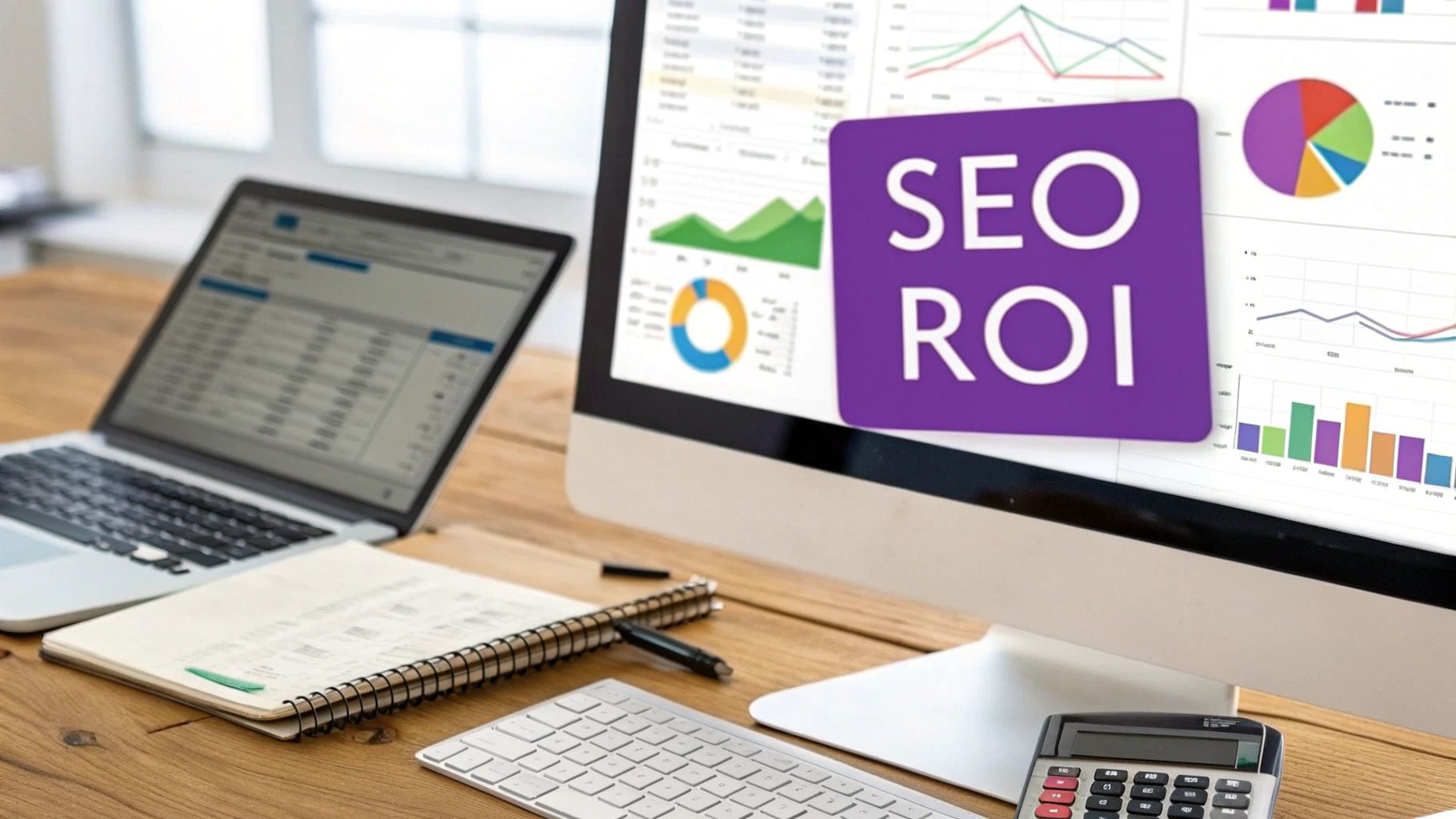
How Long Does Ecommerce SEO Take to Show Results?
This is the big one, isn't it? The honest answer is that SEO is a long game, not a quick win. While you might see some small flickers of movement in a few weeks—a keyword climbing a few spots here, a little uptick in traffic there—the real, meaningful results usually take four to six months to kick in.
That timeframe gives Google enough time to crawl and index your technical improvements, for your on-page tweaks to settle, and for your content to start gaining some authority. Think of it as planting a tree; it needs time to grow strong roots before it can bear fruit.
What Is the Most Important Part of SEO for an Online Shop?
If only it were that simple! The truth is, there’s no single "most important" part. A solid SEO strategy is all about different elements working together in harmony.
A truly effective ecommerce SEO strategy is like a well-built chair; it needs all its legs to be stable. Focusing on just one area, like keywords, while ignoring technical health or content, will ultimately cause your efforts to wobble and fail.
To build a stable foundation, you need to balance these four critical areas:
- A rock-solid technical setup so your site is fast and easy for search engines to crawl.
- Perfectly optimised product pages that capture people ready to buy.
- Genuinely valuable content that brings in customers at every stage of their journey.
- A strong reputation, built through quality backlinks and positive reviews.
Can I Do Ecommerce SEO Myself or Do I Need an Agency?
You can absolutely get your hands dirty and start with the basics yourself. Things like optimising product titles, writing unique descriptions, and getting a blog off the ground are fantastic first steps. It's a great way to wrap your head around the fundamentals.
But when you get into the more complex stuff—like site architecture, schema markup, and strategic link building—it often pays to have a specialist in your corner. Many businesses strike a happy medium: they handle the day-to-day on-page tasks in-house and bring in an agency to help scale their efforts and untangle the trickier technical challenges.
Ready to see how a professional SEO strategy can transform your online store? At Bare Digital, we offer a free, no-obligation SEO Health Check to identify your biggest opportunities. Get your bespoke activity plan and see what's possible. Get Your Free SEO Audit Today.



